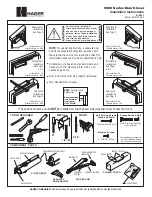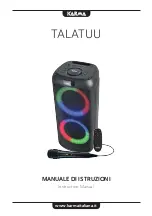
6-
EUROPEAN standard of reference, for safety and construction of arc welding
machines.
7-
Manufacturer's serial number for welding machine identification (indispensable for
technical assistance, requesting spare parts, discovering product origin).
8-
Performance of the welding circuit:
6b
TIG, MMA.
- U :
maximum no-load voltage (open welding circuit).
0
- I /U :
current and corresponding normalised voltage that the welding machine can
2
2
Choose the operating mode between welding with coated electrode (MMA),
supply during welding.
TIG welding with high frequency arc strike (TIG HF) and TIG welding with
- X :
Duty cycle: indicates the time for which the welding machine can supply the
contact arc strike (TIG LIFT).
corresponding current (same column). It is expressed as %, based on a 10 minutes
cycle (e.g. 60% = 6 minutes working, 4 minutes pause, and so on).
If the usage factors (on the plate, referring to a 40°C environment) are exceeded,
the thermal safeguard will trigger (the welding machine will remain in standby until
6c
AC/DC.
its temperature returns within the allowed limits).
When the machine is in TIG mode it is possible to choose between direct
- A/V-A/V:
shows the range of adjustment for the welding current (minimum
current welding (DC) and alternating current welding (AC) (this type of
maximum) at the corresponding arc voltage.
operation is only present for AC/DC models).
9-
Technical specifications for power supply line:
- U :
Alternating voltage and power supply frequency of welding machine (allowed
1
limit ±10%).
- I
: Maximum current absorbed by the line.
1 max
- I
:
: Effective current supplied.
1eff
6d
2T, 4T, SPOT.
10-
:
Size of delayed action fuses to be used to protect the power line.
11-
Symbols referring to safety regulations, whose meaning is given in chapter 1
With the machine in TIG mode, it allows to choose among a 4-step or a 2-step
“General safety considerations for arc welding”.
control or with spot timer.
Note: The data plate shown above is an example to give the meaning of the symbols and
numbers; the exact values of technical data for the welding machine in your possession
must be checked directly on the data plate of the welding machine itself.
6e
DC, DC PULSE, BI-LEVEL.
3.2 OTHER TECHNICAL DATA
- WELDING MACHINE: see table 1 (TAB.1).
When the machine is in TIG mode it is possible to choose between welding
- TORCH:
see table 2 (TAB.2).
with constant, pulsed or bi-level current.
The welding machine weight is shown in table 1 (TAB. 1).
7-
Keys for selecting welding parameters.
4. DESCRIPTION OF THE WELDING MACHINE
The right and left direction arrows
are used to select one of the
4.1 BLOCK DIAGRAM
The welding machine consists basically of power and control modules made on PCB's
following parameters. Settings and changes to the welding parameters are made
and optimised to achieve perfect reliability and reduced maintenance.
using the digital knob that changes the parameter and simultaneously shows its
This welding machine is controlled by a microprocessor that allows a large number of
value on the display. The LED's above the display indicate the unit of measurement
parameter settings so as to achieve perfect welding in any condition and with any
of the value on display.
material. However, to make the best use of its properties it is necessary to be fully aware
Even though on the panel it is possible to set every welding parameter freely, there
of its possibilities.
are particular parameter combinations that may have no meaning from the
electrical or welding point of view. In any case this will not damage the welding
Description (FIG. B)
machine but it may not function according to the anomalous setting.
1-
Single phase power supply input, rectifier unit and levelling capacitors.
2-
Transistor (IGBT) switching bridge and drivers;
commutes the rectified power
supply voltage to high frequency alternating voltage and adjusts the power
according to the required welding current/voltage.
3-
High frequency transformer;
the voltage converted by block 2 powers the
7a
MAIN CURRENT.
primary winding; its function is to adjust the voltage and current to the values
In TIG AC/DC and MMA modes it adjusts the value of the output current. In
needed for the arc welding procedure and at the same time to form galvanic
pulsed and BI-LEVEL modes it is the highest current level (maximum). The
separation of the welding circuit from the power supply line.
parameter is measured in amps.
4-
Secondary rectifier bridge with levelling inductance;
commutes the alternating
voltage / current supplied by the secondary winding into very low ripple direct
current / voltage.
5-
Transistor (IGBT) switching bridge and drivers;
transforms the secondary
output current from DC to AC for TIG AC welding.
7b
INITIAL AND FINAL CURRENT.
6-
Control and adjustment electronics;
controls the welding current value
instantaneously and compares it with the operator's setting; modulates the control
In TIG 4-stroke mode this is the initial and final current that is maintained all the
impulses from the IGBT drivers that make the adjustment.
time the torch button is pressed. In TIG 2-stroke mode, if the setting for the
7-
Welding machine operation control logic;
sets the welding cycles, controls the
downslope value is greater than the minimum (> 0.1 sec.) it is possible to make
actuators, supervises the safety systems.
a setting for the parameter and it takes on the meaning of final current. The
8-
Settings panel
and display of parameters and operating modes.
value can vary between the minimum ( 5A in DC, 7A in AC ) and the value of
9-
HF strike generator.
the main welding current. The two parameters use the same LED and can be
10- Protective gas solenoid valve EV.
identified on the display. The start current is indicated by "I " and the final
Str
11- Welding machine cooling fan.
current is indicated by "I
".
END
12- Remote control.
4.2 CONTROL, ADJUSTMENT AND CONNECTION DEVICES
4.2.1 BACK PANEL (FIG. C)
7c
ARC-FORCE/PRE-GAS.
1-
Power supply cable 2P + (P.E); 3P + (P.E).
2-
Main switch O/OFF - I/ON.
In MMA mode this regulates the dynamic overcurrent ("Arc-Force" adjustment
3-
Gas pipe connector (bottle pressure reducing valve welding machine).
0-100%) and the display shows the percentage increase with respect to the
4-
Remote control connector:
pre-selected welding current value. This adjustment improves welding fluidity
Using the special 14-pin connector on the back, it is possible to attach 3 different
and prevents the electrode from sticking to the piece. In TIG/HF mode it
types of remote control to the welding machine. Each device will be recognised
regulates "Pre-Gas" time in seconds (adjustment from 0-5 sec). The display
automatically and can be used to adjust the following parameters:
identifies the parameter as "Pre-Gas".
- Remote control with one potentiometer:
turning the potentiometer knob will change the main current from the minimum to
the maximum. The main current is adjusted only and exclusively by the remote
control.
- Pedal remote control:
7d
BASE CURRENT.
The current value is determined by the position of the pedal. In addition, in TIG 2-
STROKE mode pressing the pedal gives the start command to the machine
In TIG 4-stroke bi-level mode and in TIG pulsed mode this parameter
instead of the torch button.
represents the current value that can be alternated with the main current value
- Remote control with two potentiometers:
during welding. Its value can vary between the minimum (5A in DC, 7A in AC)
the first potentiometer adjusts the main current. The second potentiometer
and the main welding current value.
adjusts another parameter, depending on the active welding mode. When this
potentiometer is turned the display will show the changing value of the parameter
(which can no longer be controlled with the knob on the panel). The second
potentiometer has the following meaning: ARC FORCE in MMA mode and POST
GAS in TIG mode.
7e
FREQUENCY.
4.2.2 FRONT PANEL (FIG. D)
In TIG pulsed mode this parameter represents the pulsation frequency and
1-
Positive quick plug (+) to connect welding cable.
can take on values between 0.2Hz and 999 Hz. In addition, for AC/DC models,
2-
Negative quick plug (-) to connect welding cable.
in TIG AC mode (with pulsation disabled), the parameter represents the
3-
Connector for torch push button cable.
frequency of the alternating current and can take on values between 10Hz and
200Hz
4-
Connector for TIG torch gas pipe.
5-
Control panel.
6-
Welding mode setting keys.
7f
BALANCE.
6a
REMOTE CONTROL.
In TIG pulsed mode this parameter represents the time for which the current is
It allows to switch the control of welding parameters to the remote control.
at the higher level (main welding current) as a percentage of the total pulsation
SPOT
- 5 -






































